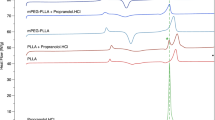Abstract
An erodible association polymer system based on blends of cellulose acetate phthalate (CAP) and Pluronic F127, a block copolymer of poly(ethylene oxide) and poly(propylene oxide), has been investigated for its applicability to rate-programmed drug delivery. The compatibility and thermal properties were characterized by DSC and FTIR. Results from the thermal analysis indicate that the blends are compatible above 50% CAP, as revealed by a single composition-dependent glass transition temperature (T g). The existence of molecular association through intermolecular hydrogen bonding between the carboxylic acid and the ether oxygen groups is supported by the observation of an upward shift in the IR carbonyl stretching frequency at increasing Pluronic F127 concentrations. Using theophylline as a model drug, the in vitro polymer erosion and drug release characteristics of the present polymer system were evaluated at different buffer pH's on a rotating-disk apparatus. The results show that the rates of both polymer erosion and drug release increase with the Pluronic F127 concentration in the blend. Further, at pH 4, the polymer erosion is minimal and the theophylline release appears to be governed mainly by diffusion through the polymer matrix. In contrast, at pH 7.4, the theophylline release is controlled primarily by the polymer surface erosion. To demonstrate the unique approach to programmed drug release based on the concept of non-uniform initial drug distribution, pulsatile patterns of drug release have been achieved successfully from the present surface-erodible polymer system using a multilaminate sample design with alternating drug-loaded layers. The results suggest that the pulsing frequency and peak rate of such pulsatile drug delivery are pH dependent; however, they can be modulated by varying the thickness, drug loading, and erosion rate of the constituent layers in the multilaminate.
Similar content being viewed by others
REFERENCES
P. I. Lee. Initial concentration distribution as a mechanism for regulating drug release from diffusion controlled and surface erosion controlled matrix systems. J. Control. Rel. 4:1–7 (1986).
P. I. Lee. Diffusion-controlled matrix systems. In A. Kydonieus (ed.), Treatise on Controlled Drug Delivery, Marcel Dekker, New York, 1992, pp. 155–197.
P. I. Lee. Novel approach to zero-order drug delivery via immobilized non-uniform drug distribution in glassy hydrogels. J. Pharm. Sci. 73:1344–1347 (1984).
J. Heller, S. Y. Ng, B. K. Fritzinger, and K. V. Roskas. Controlled drug release from bioerodible hydrophobic ointments. Biomaterials 11:235–237 (1990).
K. W. Leong, B. C. Brott, and R. Langer. Bioerodible polyanhydride as drug-carrier matrices. I. Characterization, degradation and release characteristics. J. Biomed. Mater. Res. 19:941–955 (1985).
J. Heller. Controlled release of biologically active compounds from bioerodible polymers. Biomaterials 1:51–57 (1980).
P. I. Lee and N. A. Peppas. Prediction of polymer dissolution in swellable controlled-release systems. J. Control. Rel. 6:207–215 (1987).
P. I. Lee. A coated absorbent substrate or shaped article, containing a water-soluble and/or volatile active agent. European Patent 0075540 B1, Oct. 22 (1986).
P. I. Lee. Membrane-forming polymeric systems. U.S. Patent 4,729,190, Mar. 8 (1988).
P. I. Lee. A new association polymer system for drug delivery applications. Pharm. Res. 5:S-76 (PD-816) (1988).
V. G. Levich. Physicochemical Hydrodynamics, Prentice-Hall, Englewood Cliffs, NJ, 1962.
K. G. Mooney, M. A. Mintun, K. J. Himmelstein, and V. J. Stella. Dissolution kinetics of carboxylic acids. I. Effect of pH under unbuffered conditions. J. Pharm. Sci. 70:13–22 (1981).
A. C. Riddiford. The rotating disk system. In P. Delahay (ed.), Advances in Electrochemistry and Electrochemical Engineering, Vol. 4, Wiley Interscience, New York, 1966, pp. 47–116.
S. Prakongpan, W. I. Higuchi, K. H. Kwan, and A. M. Molokhia. Dissolution rates studies of cholesterol monohydrate in bile acid-lecithin solutions using the rotating-disk method. J. Pharm. Sci. 65:685–689 (1976).
M. A. Harthcock. Probing the complex hydrogen bonding structure of urethane block copolymers and various acid containing copolymers using infra-red spectroscopy. Polymer 30:1234–1242 (1989).
E. J. Moskala, S. E. Howe, P. C. Painter, and M. M. Coleman. On the role of intermolecular hydrogen bonding in miscible polymer blends. Macromolecules 17:1671–1678 (1984).
J. Y. Lee, P. C. Painter, and M. M. Coleman. Hydrogen bonding in polymer blends. 3. Blends involving polymers containing methacrylic acid and ether groups. Macromolecules 21:346–354 (1988).
Author information
Authors and Affiliations
Rights and permissions
About this article
Cite this article
Xu, X., Lee, P.I. Programmable Drug Delivery from an Erodible Association Polymer System. Pharm Res 10, 1144–1152 (1993). https://doi.org/10.1023/A:1018960016756
Issue Date:
DOI: https://doi.org/10.1023/A:1018960016756




